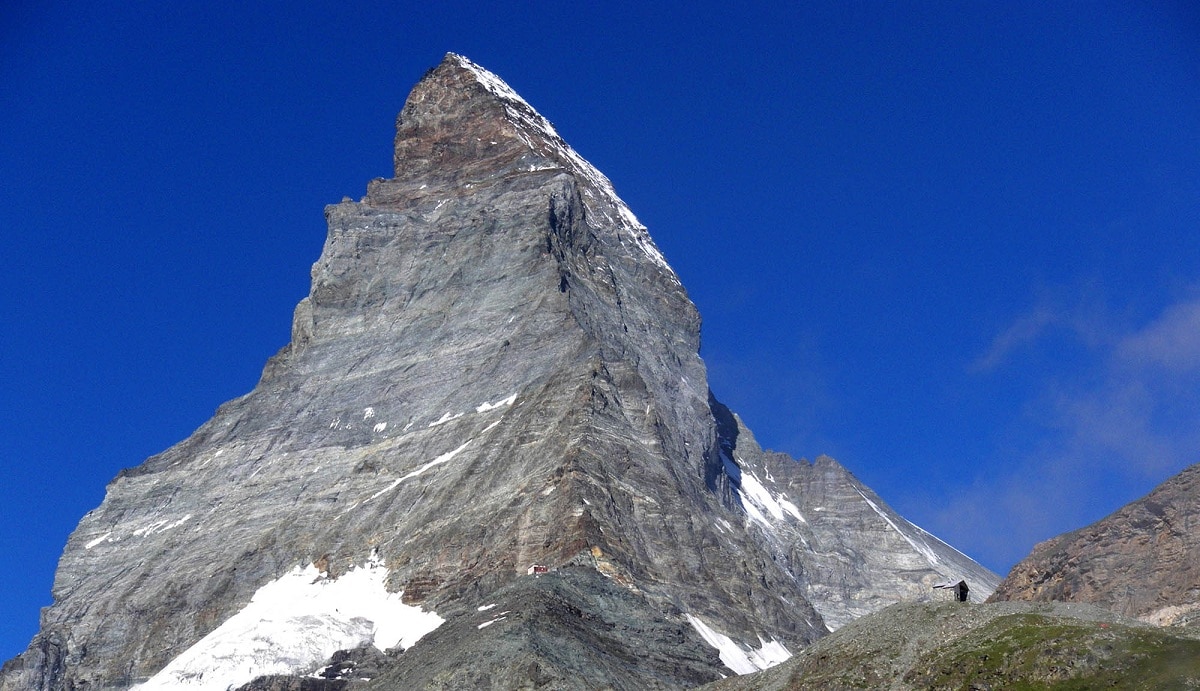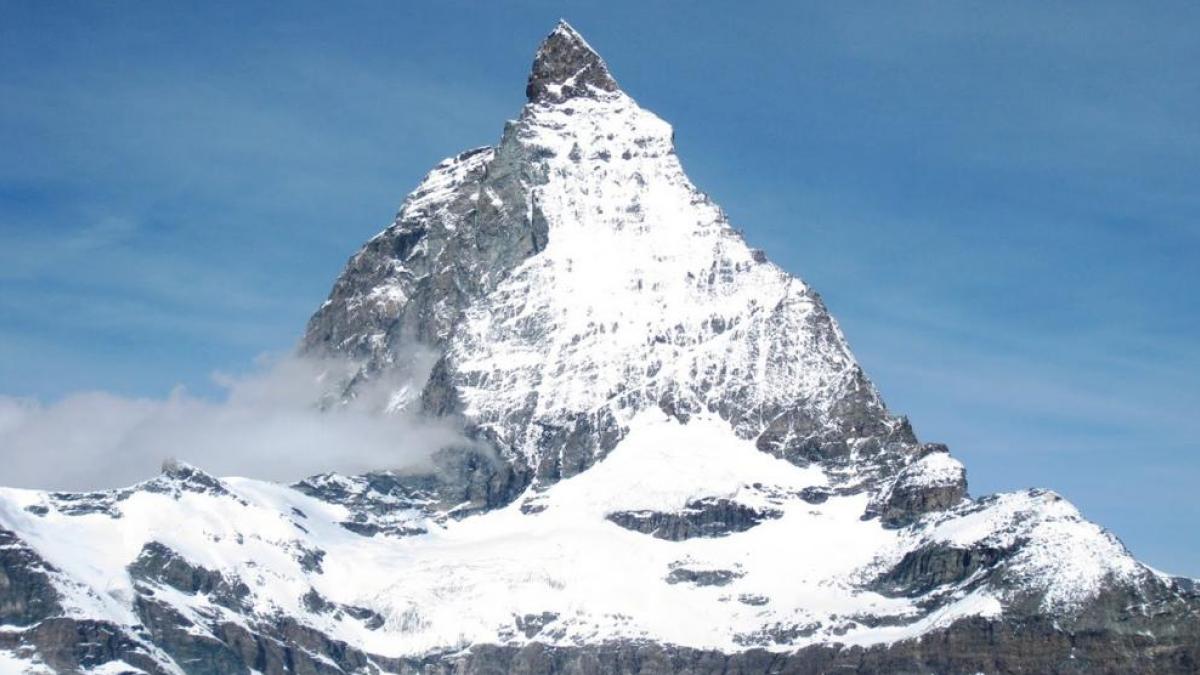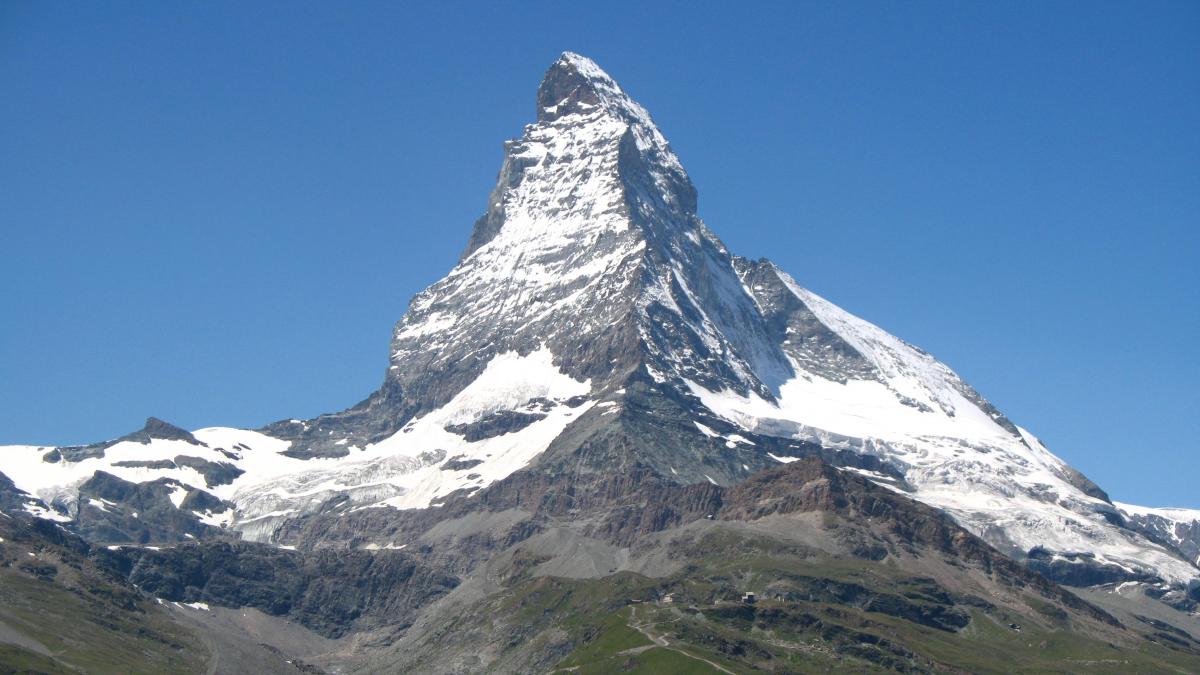
El Matterhorn It is located on the border between Switzerland and Italy. It is located above the city of Zermatt in the canton of Valais in the northeast and Breuil-Cervinia in the Aosta Valley in the south. Its peak reaches a height of 4.478 meters, making it one of the highest peaks in the Alps. It is probably the most famous mountain in the Alps, and its imposing pyramid shape has been replicated many times.
In this article we are going to tell you all the characteristics, geology, formation and much more about Mount Cervino.
Key features

The unique shape of the Matterhorn is one of the most iconic mountains in the world. This altitude in the Alps varies by region and language: Matterhorn in German and Monte Cervino in Italian and Spanish, to name a few. It seems that the name means "mountain in the meadow" in German.
Symbol of the Alps, it is one of the highest peaks in Europe, climbed for the first time in 1865 by the English mountaineer Edward Whymper.
The Matterhorn is one of the highlands of the Alps, located on the border of Switzerland and Italy. It is located in a region of mountains known as the Pennine Alps, about 10 km from Zermatt, Switzerland. It features a rare and almost perfect pyramid-shaped peak with all 4 steep and almost flat sides separated by the Leone, Zmutt, Furggen and Hörnli ridges, pointing almost directly to the 4 cardinal points. North, east, and west are aligned on the Swiss side, while south is on the Italian side.
The mountain has two peaks: the Swiss peak and the Italian peak. With an estimated height of 4.478 meters, it is the sixth highest in the Alps. Unlike other alpine mountains, its surface is not completely covered by snow and ice, but large brown sections of rock can be glimpsed, however, it has not been abandoned by large glaciers at the base of the mountain. For example, the Matterhorn Glacier sits at the base of the north face of the mountain. Mornings are usually a few degrees below zero due to elevation and snowfall, but the day can be a bit warmer.
In 2014, geologists reported in the journal Nature Revelation that they had found evidence of a huge hollow chamber inside the Matterhorn, lor that it suggests that it could have collapsed quickly and strongly at some point in history. Of course, more research is needed in this area.
Formation of the Matterhorn

Since the Matterhorn is a mountain in the Alps, its formation began when the mountain began to appear above the earth's surface. This process began when Pangea began to fragment and break up into Laurasia and Gondwana. Both masses are separated by the Tethys Ocean. The shape changed again when Earth's inner crust moved over 100 million years ago, and then Africa slowly moved towards Europe until they were very, very close to each other.
When the European continent collided with the Apulian plate, the crust folded over the course of several years. Then, about 50 million years ago, the crust began to rise until the Matterhorn was fully visible. However, it is not the same as it is today because its shape is the product of glacial erosion, and its summit is made up of several layers of rock.
Flora and fauna of the Matterhorn

Due to its natural beauty and its historical and cultural importance, this mountain is one of the most photographed mountains in the world. Around its majestic buildings, there are large green valleys full of grasses, herbs and short-flowered plants, and some trees such as conifers. The Alps are home to flowering plants that can survive over 4000 meters, but technically the upper half of the mountain is devoid of plants. The lichens are often attached to the highest rocks in the mountains and are visited by wild goats.
In terms of fauna, it is known that the mountains home to more than 30.000 species of wildlife, including mammals, birds, insects, and some reptiles. The Spanish ibex (Capra ibex) is a famous climber capable of spending a lot of time high up with little space between the rocks.
Climate
The Matterhorn has two distinct peaks, both on rocky ridges 100 meters long: the Swiss peak (4477,5 m) in the east and the Italian peak (4476,4 m) in the west. Its name comes from the first ascent, not for geographical reasons, since both are on the border. The height of the mount was first measured by Geneva geologist and explorer Horace Bénédict de Saussure in August 1792, using a 50-foot chain spanning the Theodul Glacier and a sextant. He calculated the height to be 4.501,7 meters. In 1868, the Italian engineer Felice Giordano measured the height of 4.505 meters with a mercury barometer that he took to the summit. The Dufour map, followed later by Italian explorers, gave 4.482 meters, or 14.704 feet, as the height of the Swiss summit.
A recent measurement (1999) has been made using GPS technology, which gave the height of the Matterhorn with an accuracy of one centimeter, and its changes have been checked. The result was 4.477,54 meters above sea level.
Geology
Most of the foothills are in the Tsaté nappe, the remains of the Piedmontese-Ligurian oceanic crust (ophiolite) and its sedimentary rocks. The mountain reaches a height of 3.400 meters and is made up of continuous layers of ophiolite and sedimentary rocks. From 3.400 meters to the summit, the rock is gneiss from the Dent Blanche nappe (Australian alpine rock formation). They are divided by the Arolla series (below 4.200 m) and the Valpelline belt (above). Other mountains in the region (Weisshorn, Zinalrothorn, Dent Blanche, Mont Collon) also belong to the Dent Blanche nappe.
The Matterhorn developed its characteristic pyramidal shape in more recent times due to natural erosion over the last few million years. At the beginning of the Alpine orogeny, the Matterhorn was just a round mountain like a small mountain. Due to its height above the snowline, its sides are covered in ice, causing snow to pile up and compact.
I hope that with this information you can learn more about Mount Cervino and its characteristics.